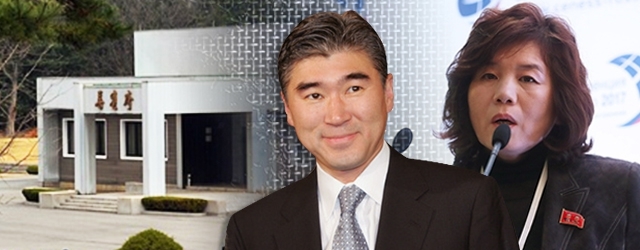 |
|
US Ambassador to the Philippines Sung Kim (left) and North Korean Vice Foreign Minister Choe Son-hui are set to meet from May 27 to 29 at Unification House (Tongilgak) on the North Korean side of Panmunjeom for agenda negotiations in preparation for the June 12 North Korea-US summit in Singapore.
|
Negotiating teams prepare to “resurrect” bilateral summit at Singapore and Panmunjeom
North Korea and the US picked up the pace on their two-track working talks on May 28, sending negotiating teams to Panmunjeom and Singapore to prepare for the their “resurrected” bilateral summit in Singapore on June 12. Due to the tight schedule, the two sides appear to have opted to speed up the negotiation process by establishing a separate “agenda team” and a “working-level preparation team” to discuss transportation, security, and protocol. At Unification House (Tongilgak) on the North Korean side of Panmunjeom, current US Ambassador to the Philippines and former Ambassador to South Korea Sung Kim held negotiations on the summit agenda for a second straight day with North Korean Vice Foreign Minister Choe Son-hui. The meeting, which is scheduled to continue through May 29, was also attended by White House National Security Council director for Korea Allison Hooker and assistant secretary of defense for Asian and Pacific security affairs Randall Shriver. The working-level preparation team is also picking up the pace. An eight-member delegation from North Korea including State Affairs Commission director Kim Chang-son – who serves in a chief of staff role for leader Kim Jong-un – arrived in Singapore via Beijing late the same evening. Around the same time, a US government aircraft arrived at Singapore International Airport carrying 30 officials, including White House Deputy Chief of Staff for Operations Joseph Hagin. The two teams appeared set to meet on May 29 to coordinate working-level matters for the summit, including transportation, security, and protocol issue. Analysts are speculating that once the two teams have established their positions in the talks, Workers’ Party of Korea vice chairman Kim Yong-chol may visit the US as early as this weekend for a high-level meeting with Secretary of State Mike Pompeo. In terms of the two tracks, the agenda talks in Panmunjeom will be a crucial stepping stone determining the summit’s success. The key issues there involve finding points of agreement on denuclearization and guarantees on the Pyongyang regime’s security. Kim Jong-un has stated his willingness to proceed with “complete denuclearization,” while US President Donald Trump has pledged to guarantee the regime’s security and provide economic support if North Korea denuclearizes. On May 27, Trump tweeted, “I truly believe North Korea has brilliant potential and will be a great economic and financial Nation one day.” Responding to a question from Democratic Party Senator Ed Markey while appearing before the Senate Foreign Relations Committee on May 24, Pompeo explained that in his meeting with Kim Jong-un, the two “spoke about what [security] assurances were going to be provided” in the “same way we’re demanding a permanent, irreversible, verifiable denuclearization.” When asked by Democratic Party Senator Ben Cardin whether he would submit an agreement between the two sides to the Senate as a treaty, Pompeo replied, “Yes, sir.” “It is our intention to achieve an agreement that would be put before the United States Senate,” Pompeo said. The issue here in the specific methodology. The US is reported hoping for visible steps toward complete, verifiable, and irreversible dismantlement (CVID) before the midterm elections in November, and complete denuclearization before the presidential election in Nov. 2020. North Korea, in contrast, has insisted it will not unilaterally denuclearization and stressed the importance of “step-by-step, simultaneous” corresponding measures. Potential for compromise The potential for compromise does exist. Appearing on a Fox News program aired on May 24, Trump explicitly used the word “phase-in.” His use of the term could be seen as acknowledging that North Korea’s advanced nuclear capabilities cannot be completely abolished overnight, opening up the possibility for some corresponding measures along the process from reporting to inspection, abandonment, and verification. In essence, the two sides would be exchanging swift and stepwise denuclearization for transitional regime security guarantees through the completion of the denuclearization process. As initial measures from North Korea, the US appears to be demanding the relocation of nuclear weapons overseas and the dismantlement of ICBMs. “The start of the denuclearization process may involve transporting a portion of the ‘past’ [completed] nukes overseas and dismantling intercontinental ballistic missiles within a two- to three-month period,” said Institute for National Security Strategy senior research fellow Cho Sung-ryul. “For this initial package, the US may open up a liaison office between Pyongyang and Washington or lift financial sanctions,” Cho suggested. Another major idea for security assurances is a trilateral declaration of the end of the Korean War, which South Korean President Moon Jae-in is currently pursuing. Speaking to reporters on May 27, a Blue House senior official named a ban on hostile activities, reaffirmation of nonaggression pledges, opening negotiations on a peace agreement, and a trilateral declaration of the Korean War’s end as possible approached to guaranteeing the Pyongyang regime’s security. By Kim Oi-hyun, Washington correspondent Please direct comments or questions to [english@hani.co.kr]






